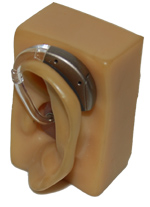Hearing Aids
Hearing aids come in a wide range of sizes and styles, including behind the ear (BTE), in the ear (ITE), in the canal (ITC) and completely in the canal (CIC). The type of hearing aid recommended depends on your individual needs. Today’s hearing aids are very unobtrusive and come in a variety of styles, colors, and patterns.

Photo: Anne Wood Humphries
Realistic Expectations and Audiologic Rehabilitation
It’s important to understand the role of hearing aids. Just as eyeglasses do not ”cure” vision deficiencies, hearing aids do not solve all hearing problems. But hearing aids can provide an important difference in your life and the lives of your family members. Hearing aid users report higher levels of involvement in social activities, fewer worries, and more positive social and family experiences than those who have uncorrected hearing loss. Today, over 95% of patients with hearing loss can successfully wear hearing aids.
Audiologists provide additional services and procedures for lessening or compensating for hearing impairment. Various approaches involve auditory training, speech reading, and improving listening skills with assistive devices.

Photos: Robert Ladd


 Prevention
Prevention





